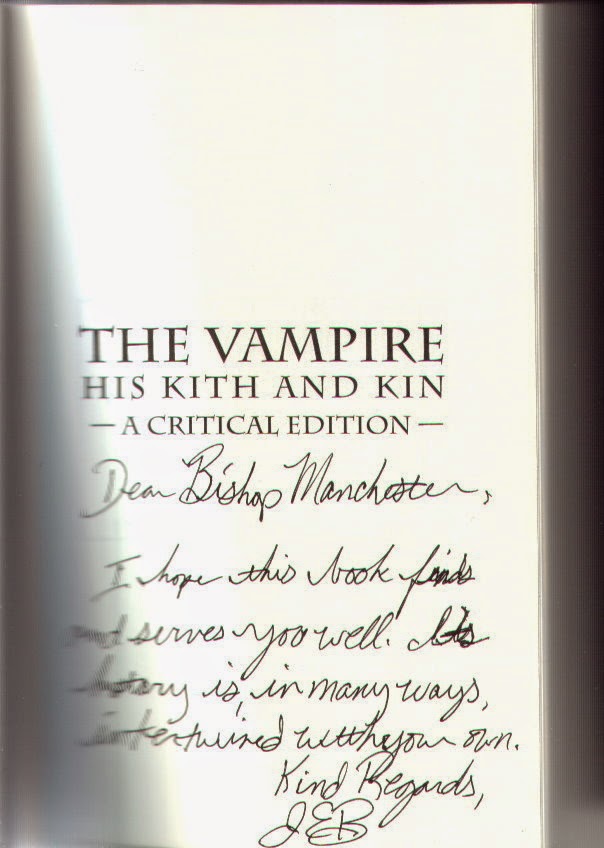Seán Manchester (from his writings) on Montague Summers:
Someone called Robertson Davies, a decade ago, expressed the view that Montague Summers' orders were in dispute and that he had never been a member of a Catholic jurisdiction or diocese. This falsehood has been repeated on Wikipedia, which I know from bitter experience gets an awful lot wrong; not least with its Highgate Vampire article which entry is written by Jacqueline Simpson, someone who relied entirely on flawed newspaper cuttings and an American colleague of hers by the name of Bill Ellis who is exceptionally biased and who, in turn, also relied on extremely unsafe information. (See: http://www.holygrail-church.fsnet.co.uk/RaisingDevil.htm)
There is no dispute in my mind as to whether Montague Summers was ordained into the priesthood; none whatsoever; moreover, he was not only ordained a priest but also episcopally consecrated in the winter of his life.
There is no dispute in my mind as to whether Montague Summers was ordained into the priesthood; none whatsoever; moreover, he was not only ordained a priest but also episcopally consecrated in the winter of his life.
Alphonsus Joseph-Mary Augustus Montague Summers, in whose memory I dedicated the second edition of The Highgate Vampire, entered the Old Catholic priesthood (having been diaconated in 1908 in the Church of England, and joining the diaconate in the Roman Catholic Church which he entered a year later).
Summers grew up in a wealthy family living in Clifton, near Bristol. Religion always played a large part in his life. He was raised as an evangelical Anglican, but his love of ceremonial and sacraments drew him to Anglo-Catholicism. After graduating in Theology at Oxford he took the first steps towards holy orders at Lichfield Theological College and entered his apprenticeship as a curate in the diocese of Bitton near Bristol. A year or so later he converted to Roman Catholicism. He had been made a deacon within the Church of England in 1908, and was diaconated again within the Roman Catholic Church, but it was not until he embraced the Old Catholic Church that he was ordained into the priesthood in 1913. He celebrated Mass publicly when travelling abroad, but at home in England he only performed this sacrament in private. This was probably due to the fact that he was ordained into the priesthood outside the regular procedures of the Church. Old Catholic holy orders, albeit valid, are irregular in the eyes of Rome and Canterbury.
He was episcopally consecrated for the Order of Corporate Reunion on 21 June 1927 by Dominic Albert Godwin. He was later consecrated sub conditione on 21 March 1946 by Roger Stephen Matthews and appointed Nuncio for Great Britain. Like myself, he wrote books about demonology whilst placing significant emphasis on exorcism.
By far his most impressive and, for me, most informative and fascinating works are The Vampire: His Kith and Kin, and The Vampire in Europe. The Vampire: His Kith and Kin examined the reasons for the old belief in vampirism, its growth and dissemination in many lands, and its crystallisation into a permanent and determinate legend. This second volume, The Vampire in Europe, uniform with the other, deals with the subject from a historical point of view and presents the evidence which gave rise to the theories. This evidence, drawn from little-known authors, musty chronicles, and the obscurer occultists, is in many cases derived from official sources, civil and ecclesiastical. The first chapter deals with vampirism in ancient Greece and Rome. Accounts of the extraordinary outbreaks of vampirism in England during the twelfth and thirteenth centuries have been gathered from Geoffrey of Monmouth and William of Newburgh. Particular attention is paid to the contagion outbreak which gave rise to so much literature in the early eighteenth century, while the curious situation in modern Greece is also fully discussed.
Included in the latest critical editions from the Apocryphile Press is the authoritative text, rare contextual and source materials, illustrations, criticism, contemporary reviews, and Greek and Latin translations. A biographical note is also present.
Included in the latest critical editions from the Apocryphile Press is the authoritative text, rare contextual and source materials, illustrations, criticism, contemporary reviews, and Greek and Latin translations. A biographical note is also present.





No comments:
Post a Comment